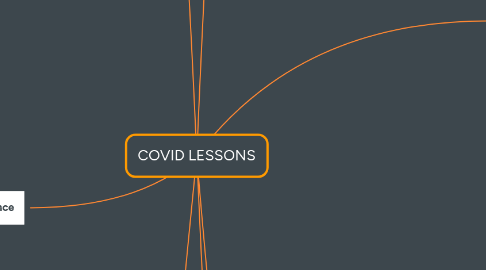
1. Learning Reimagined
1.1. Efficiency
1.1.1. Non-academic work can be done remotely
1.1.1.1. Few if any negative consequences
1.1.1.2. Reduce administrative space
1.1.1.3. Reduce parking needs
1.1.2. Partnerships across institutions
1.1.2.1. Eliminate
1.1.2.1.1. Duplication
1.1.2.1.2. Redundancy
1.2. Address learning gaps
1.2.1. Absenteeism
1.2.1.1. Look for those at high risk of disengagement and dropping out
1.2.2. Support the least prepared
1.3. More support for teachers
1.3.1. Teacher collaboration
1.3.1.1. Experiment
1.3.1.2. Innovate
1.3.2. Drivers of their own learning
1.3.3. Educator wel-being
1.3.3.1. Self-efficacy
1.3.3.2. Job satisfaction
1.3.3.3. working conditions
1.3.3.4. Relationships
1.3.4. Leaders in Learning
1.3.4.1. Professional autonomy
1.3.4.2. Capacity for innovatoin
1.3.5. Professional learning
1.3.6. Employ research about learning to help structure organizations focused on advancing learning.
1.3.6.1. Students disadvantaged during COVID because this was A priority prior to the pandemic, not THE priority.
1.3.6.2. Learn how to bring this into the home
1.4. Strategy
1.4.1. Contingency planning
1.4.1.1. Better prepare for disruption
1.4.1.1.1. Scenario plannning
1.5. Standardized Tests
1.5.1. Limitations exposed
1.5.2. Need innovation
1.5.2.1. needs-based assessments
1.5.2.2. diagnostic assessments
1.6. More funding (OECD Link)
1.7. Reality check
1.7.1. Students know they can learn remotely
1.7.2. Fewer summative assessments
1.7.2.1. Lack of knowledge of student standing
1.7.2.2. New ways to gain understanding
1.7.2.2.1. co-creation
1.7.3. EdTech
1.7.3.1. Not a substitute for connecting with students
2. Sources
2.1. Lessons Learned from COVID: Leaders Share Challenges and Bright Spots
2.2. Learning From COVID-19
2.3. 4 lessons learned from COVID-19
2.4. BEYOND THE PANDEMIC: LESSONS LEARNED FROM COVID 19
2.5. Lessons from COVID-19 in the Education Sector
2.6. COVID-19 and student performance, equity, and U.S. education policy
2.7. What lessons from the coronavirus pandemic will shape the future of education?
2.8. Pandemic Lessons for a Post-COVID-19 Classroom
2.9. OECD: Educators need new skills and new knowledge to capitalise on new education priorities and means of delivery
2.10. OECD: Addressing learning gaps now will minimise disruption in students’ educational journeys
3. The Learning Experience
3.1. Communication
3.1.1. Activities
3.1.1.1. Sharing information
3.1.1.2. Listening
3.1.1.3. Asking questions
3.1.2. Approaches
3.1.2.1. Webinars
3.1.2.2. Dialog sessions
3.1.2.3. Alumni and donor meetings
3.1.2.4. Written corresondence
3.1.2.5. Informational vidoes
3.1.2.6. New training materials
3.1.2.7. Return to campus website
3.1.3. How to return safely to
3.1.3.1. formal events
3.1.3.2. informal events
3.2. Data-driven
3.2.1. Adapting plans based on input and data
3.3. Shift to remote
3.3.1. Results
3.3.1.1. Most student housing empty
3.3.1.2. Eliminated almost all non-academic activities
3.3.1.2.1. Sports
3.3.1.3. Highly variable levels of institutional support for remote learning.
3.4. General learning
3.4.1. Teaching and learning is core
3.4.2. Failure to learn from pandemic "will threaten both the resilience and the relevancy of every postsecondary institution."
3.5. Remotely learning
3.5.1. Engagement
3.5.1.1. Adopt lessons from remote schooling
3.5.1.1.1. Modified curriculum?
3.5.1.1.2. Contact time?
3.5.1.1.3. Pedagogical strategies?
3.5.1.1.4. Reduced lectures
3.5.1.2. Not hours
3.5.2. Exhasusting
3.5.2.1. Reduce screen time
3.5.2.2. Teachers
3.5.2.2.1. Ignored new tech
3.5.2.2.2. 1 new system/device per quarter?
3.5.2.2.3. Forums
3.5.2.3. Managing day-to-day work product productio
3.5.2.3.1. Students
3.5.2.3.2. Faculty
3.6. Horror Stories
3.6.1. No recording of sessions
3.6.1.1. Teachers worried about being replaced
3.6.1.2. No way to recover from Internet interruption
3.7. Learner leadership teams
3.7.1. Learners contribute to peer success
3.7.1.1. plan
3.7.1.2. Evaluate
3.7.1.3. Run breakouts
3.8. Remove barriers
3.8.1. Teach how to use
3.8.1.1. Devices
3.8.1.2. Software
3.8.1.2.1. Access to
3.8.2. Are families aware of expectations
3.8.3. Time to complete homework
3.8.3.1. What does homework mean for those already at home?
4. Learning is more than education
4.1. Whole student
4.1.1. Fear
4.1.2. Anxiety
4.1.3. Physical health
4.1.4. Wellness
4.1.5. Isolation
4.1.6. mental health
4.2. Interrupted learning
4.2.1. Virus
4.2.1.1. Parents
4.2.1.2. Teachers
4.2.1.3. Students
4.3. Educators mindful of basic needs
4.3.1. Social?
4.3.2. Emotional?
4.3.3. An issue even before pandemic?
4.4. Build sense of community
4.4.1. Engage the family
4.4.1.1. Regularly interview families on what is
4.4.1.1.1. working
4.4.1.1.2. not working
4.4.1.2. Juggling parenting time
4.4.1.2.1. Work
4.4.1.2.2. Medical issues
4.4.2. Engage the community
4.4.2.1. How do we serve the communiy
4.4.2.1.1. underserved
4.4.2.2. Porch visits
4.4.2.2.1. Much to learning from community
4.4.2.2.2. Never assume
4.4.2.2.3. Multiple channels of communication
4.4.2.2.4. Pride and joy in seeing teachers at their homes
4.4.2.3. Have learners teach about their neighborhoods
4.4.2.4. This takes time
4.4.3. Students as learning community
4.4.3.1. Learning about student home environment
4.4.3.1.1. Struggles
4.4.3.1.2. Hardships
4.4.4. English Learners
4.5. Equitability
4.5.1. High-quality, inclusive materials
4.5.2. Social-emotional development
4.5.3. Extra help exposed more
4.5.3.1. Nannies
4.5.3.2. Tutors
4.6. Breadth of activities
4.6.1. Provide access to learning
4.6.2. Academic support
4.6.3. Language support
4.6.4. Basic needs
4.6.5. Affection
4.6.6. Socialization
4.6.7. Community
4.6.7.1. Outreach
4.6.7.2. Building
4.6.7.2.1. Communications
4.6.7.2.2. Engagement
4.6.8. Integrate nature
4.6.8.1. Plan for outside learning
5. Learning models
5.1. More personalized
5.1.1. Plans
5.1.1.1. Learners
5.1.1.2. Families
5.2. Meeting students where they are
5.2.1. How to measure each learner's performance
5.3. One size does not fit all
5.3.1. Offer options
5.3.1.1. Writing
5.3.1.1.1. Select genre for assignments
6. Technology
6.1. Continued access (digital divide)
6.1.1. Devices
6.1.1.1. Loan programs
6.1.1.1.1. Computers
6.1.1.1.2. Scanners
6.1.2. Internet Access
6.1.2.1. school sponsored hotspots
6.1.3. Skills
6.2. Increased feedback
6.2.1. Technology platforms
6.2.1.1. Faster product revision cycle
6.2.1.1.1. Hard to keep up with changes
6.3. Use of technology
6.3.1. enhance learning
6.3.2. increase access
6.3.3. Promote completion
6.4. Master online platforms
6.5. Old, hand-me-down tech won't cut it
6.6. Provide educators with tools that meet their specific needs
7. Role of Higher-Ed
7.1. restoring economic vibrancy
7.1.1. Displaced workers
7.1.1.1. reskilling
7.1.1.2. upskilling
7.1.2. Future needs
7.1.2.1. short-term certificates
7.1.2.2. one-year graduate programs
7.1.2.3. one-year baccalaureate programs
7.1.2.4. Address emerging needs of industries
7.1.2.4.1. Listening and adapting to employers
7.1.2.4.2. Does not compromise broader educational aims
7.1.3. Role of research university as source of thinking during uncertain times.
